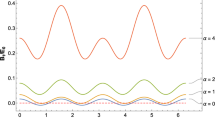Abstract
At present classical physics contains two contradictory groups of derivations of the equilibrium spectrum of random classical electromagnetic radiation. One group of derivations finds Planck's spectrum based upon the use of classical electromagnetic zero-point radiation and fundamental ideas of thermodynamics. The other group of derivations finds the Rayleigh-Jeans spectrum from scattering equilibrium for non-linear mechanical systems in the limit of small charge coupling to radiation. Here we examine the scaling symmetries of classical thermal radiation. We find that, in general, classical mechanical systems do not share the scaling symmetries of thermal radiation. In particular, this is true for the mechanical scattering systems used in the derivations of the Rayleigh-Jeans law. Indeed, relativistic hydrogenlike systems with Coulomb potentials of fixed charge are the only mechanical potential systems which do share the scaling symmetries of thermal radiation. We propose that only these last mechanical systems are allowed in a classical electromagnetic description of nature.
Similar content being viewed by others
References
M. Born,Atomic Physics, 7th edn. (Hafner, New York, 1966), Chap. 8, Sec. 1; R. Eisberg and R. Resnick,Quantum Physics of Atoms, Molecules, Solids, Nuclei, and Particles (Wiley, New York, 1974), Chap. 1.
T. H. Boyer,Phys. Rev. 182, 1374 (1969).
T. H. Boyer,Phys. Rev. 186, 1304 (1969).
T. H. Boyer,Phys. Rev. D 27, 2906 (1983);29, 2418 (1984).
T. H. Boyer,Phys. Rev. D 29, 1089, 1096 (1984);30, 1228 (1984).
T. H. Boyer,Phys. Rev. D 13, 2832 (1976).
T. H. Boyer,Phys. Rev. A 18, 1228 (1978).
L. Pesquera and P. Claverie,J. Math. Phys. 23, 1315 (1982).
R. Blanco, L. Pesquera, and E. Santos,Phys. Rev. D 27, 1254 (1983);29, 2240 (1984); R. Blanco and L. Pesquera,Phys. Rev. D 33, 421 (1986);34, 1114 (1986); R. Blanco, L. Pesquera, and J. L. Jimenez,Phys. Rev. D 34, 452 (1986).
H. A. Lorentz,The Theory of Electrons (Dover, New York, 1952). This is a republication of the 2nd edition of 1915. Note 6, p. 240, gives Lorentz's explicit assumption on the boundary conditions.
T. H. Boyer,Phys. Rev. D 11, 790, 809 (1975).
In ref. 11, p. 798.
H. A. Kastrup,Ann. Phys. (Leipzig) 9, 388 (1962).
H. A. Kastrup,Phys. Lett. 3, 78 (1962). See the remarks and footnote on page 78.
A. Sommerfeld,Thermodynamics and Statistical Mechanics (Academic Press, New York, 1956). See pages 140–145.
Author information
Authors and Affiliations
Rights and permissions
About this article
Cite this article
Boyer, T.H. Scaling symmetry and thermodynamic equilibrium for classical electromagnetic radiation. Found Phys 19, 1371–1383 (1989). https://doi.org/10.1007/BF00732758
Received:
Issue Date:
DOI: https://doi.org/10.1007/BF00732758




